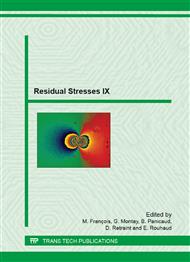[1]
I.A. Choudhury, M.A. El-Baradie, Machinability of nickel-base super alloys: a general review, J. Mater. Process. Technol. 77 (1998) 278-284.
DOI: 10.1016/s0924-0136(97)00429-9
Google Scholar
[2]
D. Dudzinski, A. Devillez, A. Moufki, D. Larrouquere, V. Zerrouki, J. Vigneau, A review of developments towards dry and high speed machining of Inconel 718 alloy, Int. J. Mach. Tools Manuf. 44 (2004) 439-456.
DOI: 10.1016/s0890-6955(03)00159-7
Google Scholar
[3]
A. Sadat, M. Reddy, Surface integrity of inconel-718 nickel-base superalloy using controlled and natural contact length tools. Part I: Lubricated, Exp. Mech. 32 (1992) 282-288.
DOI: 10.1007/bf02319367
Google Scholar
[4]
A. Sadat, M. Reddy, Surface integrity of inconel-718 nickel-base superalloy using controlled and natural contact length tools. Part II: Unlubricated, Exp. Mech. 33 (1993) 343-348.
DOI: 10.1007/bf02322151
Google Scholar
[5]
A. Sharman, J. Hughes, K. Ridgway, An analysis of the residual stresses generated in Inconel 718™ when turning, J. Mater. Process. Technol. 173 (2006) 359-367.
DOI: 10.1016/j.jmatprotec.2005.12.007
Google Scholar
[6]
M. El-Khabeery, M. Fattouh, Residual stress distribution caused by milling, Int. J. Mach. Tools Manuf. 29 (1989) 391-401.
DOI: 10.1016/0890-6955(89)90008-4
Google Scholar
[7]
O. Vohringer, Relaxation of residual stresses by annealing or mechanical treatment, Pergamon Press, Adv. Surf. Treat. 4 (1987) 367-396.
Google Scholar
[8]
I.C. Noyan, J.B. Cohen, Residual stress measurement by diffraction and interpretation, (1987).
Google Scholar
[9]
A.J. Wilkinson, P.B. Hirsch, Electron diffraction based techniques in scanning electron microscopy of bulk materials, Micron. 28 (1997) 279-308.
DOI: 10.1016/s0968-4328(97)00032-2
Google Scholar
[10]
V. Bushlya, J.M. Zhou, F. Lenrick, P. Avdovic, J-E. Ståhl, Characterization of White Layer Generated when Turning Aged Inconel 718, Procedia Eng. 19 (2011) 60-66.
DOI: 10.1016/j.proeng.2011.11.080
Google Scholar
[11]
M. Moore, W. Evans, Mathematical correction for stress in removed layers in X-ray diffraction residual stress analysis, SAE Technical Paper (1958).
DOI: 10.4271/580035
Google Scholar
[12]
H. Yuan, W. Liu, Effect of the δ phase on the hot deformation behavior of Inconel 718, Mater. Sci. Eng. A 408 (2005) 281-289.
Google Scholar
[13]
D. Dye, K. Conlon, R. Reed, Characterization and modeling of quenching-induced residual stresses in the nickel-based superalloy IN718, Metall. Mater. Trans. A 35 (2004) 1703-1713.
DOI: 10.1007/s11661-004-0079-7
Google Scholar


